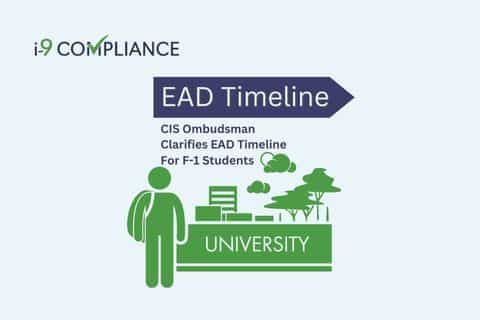CIS Ombudsman Clarifies EAD Timeline For F-1 Students

August 29, 2023
The U.S. Citizenship and Immigration Services (USCIS) recently announced a reminder for students returning to colleges and universities across the United States. This announcement concerns the timeline for receiving an employment authorization document (EAD).
Furthermore, the USCIS reminds students that these EADs allow them to complete the employment eligibility verification (Form I-9) process so they may work while school is in session. The agency made this announcement in response to many complaints about students encountering delays in receiving their EADs despite paying for premium processing.
In addition to the announcement, the American Immigration Lawyers Association posted a notice affecting students. It offered a reminder by the Office of the Citizenship and Immigration Services Ombudsman (CIS Ombudsman) that the timeline for producing versus processing EADs is separate. The CIS Ombudsman emphasized this by providing a notice detailing when F-1 students can expect their EADs. However, this timeline depends on when their Application for Work Authorization (Form I-765) is approved.
On March 6, 2023, the USCIS announced it would extend premium processing for Form I-765 to certain F-1 students. This extension allowed students to file their Requests for Premium Processing Service (Form I-907) online. The USCIS intended this change to streamline adjudicating properly filed EAD requests.
Approved Form I-907s begins a 30-day timeframe for the USCIS to adjudicate paperwork for requested EADs. The CIS Ombudsman also clarified that the USCIS generally processes properly completed forms in the following sequence:
- Approval
- Denial
- Sending a notice of intent to deny, or
- Sending a request for evidence.
However, the CIS Ombudsman clarified that students should not expect to receive an EAD at the end of this timeline. The time it takes to approve an EAD is different from the time taken to produce it. As such, the actual time to make an EAD may extend the wait.
The CIS Ombudsman further assured students that EADs typically take one to two weeks for the USCIS to produce. In addition, they may expect to receive the EAD through the U.S. Postal Service (USPS). The final arrival date will depend on USPS delivery times, not the USCIS.
Students and employers should plan accordingly with this information. For example, they could discuss the documentation they will use to complete the student’s Form I-9. Completing this form has proven difficult due to the various documents employees may present as work authorization and proof of identity.
The best way for employers to remain compliant is to incorporate an electronic I-9 management system into the hiring process. This system can provide step-by-step guidance, electronic storage, and helpful reminders when to take action to remain compliant.
Make things a little less complicated for your business by automating your employment eligibility verification and ensuring compliance with I-9Compliance.